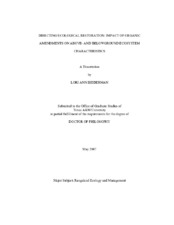| dc.description.abstract | Increasing interest among restoration ecologists exists in developing strategies
that stimulate biotic interactions and promote self-regulation in restored systems. These
approaches should target above- and belowground organisms because they interact to
regulate ecosystem pattern and process. In the following dissertation, I compare the
ability of organic amendments to alter above- and belowground biological community
structure and function to promote prairie establishment on Castle Drive Landfill in
Garland, Dallas County, Texas. Treatments included altering the location of organic
amendments in the soil profile, either applied to surface or incorporated, and varying the
amount applied. Plant community composition, grass population dynamics, soil nutrient
conditions, and soil biological parameters were monitored for three growing seasons.
Aboveground, the surface treatments were superior for the establishment of
desired and undesired plant species. Plant density patterns can be attributed to the
amelioration of physical conditions and the accidental burial of seed during
incorporation. Grass population dynamics suggest that surface-amended plots supported establishment, but high-volume incorporated treatments were better for enhancing
survival through seasonal and long-term drought. Belowground biological responses
were affected by the plant community, and not by the amendment treatments. Soil
microbial biomass and carbon mineralization potential were larger in those treatments
with greater plant density. The structure of the nematode community suggests that
decomposition in the surface-amended plots was directed through bacterial channels
while decomposition in the incorporated plots was through fungal channels. It is likely
that the higher rates of plant productivity in surface treatments stimulated root exudation,
thereby favoring bacteria and the nematodes that feed on them. Treatment differences in
decomposition pathway were attenuated after 17 months. The soil quality indicators,
Cmic/Corg, qCO2, nematode family richness and nematode density, were not affected by
the restoration treatments or plant density, but did increase over time. The results of this
study suggest that restoration managers should direct their energies into establishing and
promoting a high-quality plant community. This can be manipulated with amendments,
but care is needed not to exceed thresholds within location treatments. | en |


